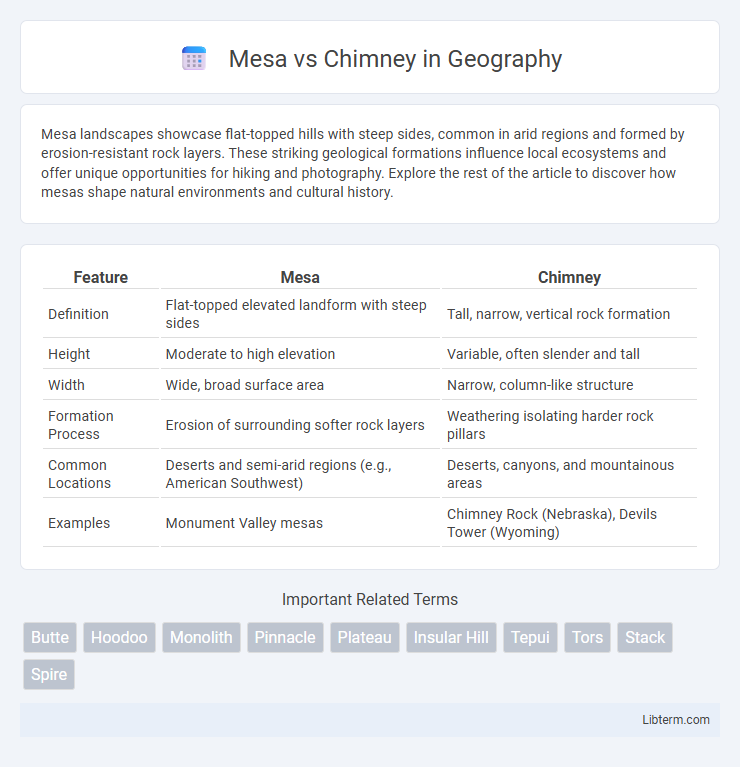Mesa landscapes showcase flat-topped hills with steep sides, common in arid regions and formed by erosion-resistant rock layers. These striking geological formations influence local ecosystems and offer unique opportunities for hiking and photography. Explore the rest of the article to discover how mesas shape natural environments and cultural history.
Table of Comparison
| Feature | Mesa | Chimney |
|---|---|---|
| Definition | Flat-topped elevated landform with steep sides | Tall, narrow, vertical rock formation |
| Height | Moderate to high elevation | Variable, often slender and tall |
| Width | Wide, broad surface area | Narrow, column-like structure |
| Formation Process | Erosion of surrounding softer rock layers | Weathering isolating harder rock pillars |
| Common Locations | Deserts and semi-arid regions (e.g., American Southwest) | Deserts, canyons, and mountainous areas |
| Examples | Monument Valley mesas | Chimney Rock (Nebraska), Devils Tower (Wyoming) |
Mesa vs Chimney: Key Geological Differences
Mesa and chimney formations differ significantly in their geological structures and formation processes. A mesa is a flat-topped hill with steep sides, formed primarily through erosion-resistant rock layers that protect softer underlying strata from weathering. In contrast, a chimney is a slender, vertical rock column created by differential erosion, often originating from the collapse or isolation of rock pillars within canyons or cliff faces.
Formation Processes: Mesa vs Chimney
Mesas form through the gradual erosion of horizontal rock layers, where resistant caprock protects the softer underlying strata from weathering, resulting in flat-topped hills with steep sides. Chimneys, also known as hoodoos, develop when differential erosion isolates narrow spires of rock, often due to varying hardness in sedimentary layers, causing dramatic vertical columns. The key difference lies in their erosion mechanisms: mesas preserve extensive flat surfaces while chimneys emerge from focused vertical erosion shaping slender rock columns.
Distinctive Physical Characteristics
A mesa features a flat-topped hill with steep, often vertical, sides formed by erosion-resistant rock layers, typically found in arid regions. In contrast, a chimney refers to a tall, slender rock spire or pillar, created by weathering processes that isolate narrow rock columns from larger formations. The key distinction lies in mesas' broad, plateau-like surfaces versus chimneys' narrow, towering structures.
Global Locations: Where to Find Mesas and Chimneys
Mesas are prominently found in arid regions such as the southwestern United States, particularly in Arizona, New Mexico, and Utah, as well as parts of Mexico and Spain. Chimneys, often referred to as hoodoos, are widespread in areas like Bryce Canyon in Utah, the Cappadocia region of Turkey, and parts of the Canadian Badlands. Both geological formations are shaped by erosion but appear in distinct landscapes globally, with mesas characterized by flat tops and chimneys by tall, narrow spires.
Erosion and Weathering: Impact on Mesas and Chimneys
Erosion and weathering play crucial roles in shaping mesas and chimneys by breaking down rock layers and gradually removing softer materials, leading to their distinct formations. Mesas typically form from the erosion of extensive plateaus, leaving behind flat-topped, steep-sided landforms resistant to weathering. Chimneys, or hoodoos, result from differential erosion where harder rock caps protect the column beneath from rapid erosion, producing slender, isolated spires.
Ecological Significance of Mesas vs Chimneys
Mesas and chimneys both play critical roles in their respective ecosystems, with mesas serving as elevated habitats that support diverse flora and fauna due to their isolation and unique microclimates. Chimneys, often formed as slender rock spires, provide nesting sites for specialized bird species and contribute to soil formation through erosion. The varying ecological significance of mesas lies in their ability to preserve endemic plant species, while chimneys act as key geological structures influencing local biodiversity and landscape stability.
Cultural and Historical Importance
Mesas and chimneys feature prominently in the cultural and historical narratives of Indigenous peoples in the American Southwest, symbolizing sacred landscapes and ancient geological formations. Mesas, with their flat-topped elevations, often served as strategic sites for settlements and ceremonial activities, reflecting a deep connection to ancestral heritage. Chimneys, towering rock spires formed through erosion, are celebrated as natural monuments that inspire local folklore and artistic expression, embodying the region's dynamic geological history.
Popular Mesas and Chimneys Around the World
Mesa formations such as the iconic Monument Valley in the United States and Table Mountain in South Africa showcase flat-topped hills with steep sides, carved by erosion over millions of years. Famous chimneys like the Fairy Chimneys of Cappadocia, Turkey, feature tall, thin spires of rock formed through volcanic activity and erosion, creating unique and dramatic landscapes. Both geological features attract millions of tourists annually due to their distinct shapes and cultural significance worldwide.
Scientific Studies: Insights into Mesas and Chimneys
Scientific studies reveal that mesas are flat-topped landforms with steep sides, formed primarily through erosion-resistant sedimentary rock layers, while chimneys are vertical rock spires resulting from differential weathering processes. Geological surveys and remote sensing techniques highlight how mesas preserve ancient stratigraphy, providing valuable paleoenvironmental records. Research on chimney formations enhances understanding of localized erosion dynamics and rock strength variations in arid landscapes.
Mesa vs Chimney: FAQs and Common Misconceptions
Mesa and chimney are distinct geological formations often confused due to their flat tops, but mesas are broad, flat-topped uplands with steep sides formed by erosion, while chimneys are narrow, tower-like rock columns resulting from differential weathering. Frequently asked questions highlight that mesas are larger and more stable landforms, contrasted with the slender and fragile structure of chimneys. Common misconceptions include mistaking chimneys for small mesas or assuming both landforms have similar formation processes, when in fact chimneys are erosional remnants of mesas or plateaus.
Mesa Infographic

 libterm.com
libterm.com